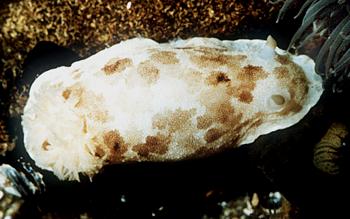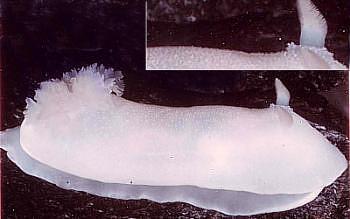White and yellow sea lemons
October 23, 2000
From: Sandra Millen


Hi Bill,
Concerning your request for my views on the photos of Archidoris montereyensis, Archidoris odhneri and Anisodoris nobilis and similar looking dorids recently sent to the Forum by Jeff Goddard and Clinton Bauder, I offer the following suggestions.
Clinton's photo of two dorids, one white, one yellow is, I suspect, Geitodoris heathi rather than Archidoris montereyensis. This animal has even more extremes in color variability than Anisodoris lentiginosa. I think they are Geitodoris because they are flat and the tubercles look low and rounded - but it is very hard to tell from this photo.
Even though I described Anisodoris lentiginosa, I never saw the color pattern shown by Jeff Goddard and Clinton Bauder. Smaller animals were either pure white or creamy yellow and had no spots, larger animals had varying amounts of brown blotching, usually pale but often with a few dark areas. The spots did not cover the tubercles. I find it interesting that Jeff and Clinton's photo's show a faint light ring around the dark spots. The tubercle pattern is like that of A. lentiginosa as is the body shape in Jeff's photo. Clinton's animal looks rather flat and the rhinophores do not show the characteristic backwards slant, but both of those differences could be due to the angle of the shot. One way to tell for sure, would be to look at the penis, which has unique, broad, serrated spines. If anyone sends me a preserved sample of this presumed color variety, I'd be happy to check it out. I think this 'mystery dorid' (lower right) in size, gills and tubercles is Anisodoris lentiginosa. It is probably a color variety I havn't seen, which doesn't mean a lot because I have seen them from pure white or cream to quite mottled. I am sending you a photo of both extremes.
By the way, Anisodoris nobilis is the only one of these doruds with a distinct lemon scent. Its citrus fruit aroma is quite pleasant and usually only given off when the animal is handled. Another scented nudibranch on the west coast of North America is Melibe leonina. It has a a sweet fruity aroma which you can smell throughout the room when a number of them are in a tank. It tends to 'get to you' like a bad perfume. They are gregarious animals and probably use it to keep together.
I agree the photo on the lower left of Clinton's message is Archidoris odhneri.
Sandra
millen@zoology.ubc.ca
Millen, S., 2000 (Oct 23) White and yellow sea lemons. [Message in] Sea Slug Forum. Australian Museum, Sydney. Available from http://www.seaslugforum.net/find/3195Dear Sandra,
Thanks for your help in clarifying these dorids from the west coast of North America. I must say it all looked fairly easy when I just had Dave Behren's book to look at, but once the variations began to appear....
And thanks for the information about the citrus smell of Anisodoris nobilis. I feel much happier knowing that sea lemons get their name from the scent of one of them rather than their colour and shape.
Best wishes,
Bill Rudman.
Related messages
-
Diaulula lentiginosa? from Carmel, California
From: Clinton Bauder, July 5, 2005 -
Anisodoris lentiginosa? from British Columbia
From: Clinton Bauder, August 9, 2002 -
Anisodoris lentiginosa from British Columbia (2)
From: Clinton Bauder, August 9, 2002 -
More photos of Anisodoris lentiginosa
From: Clinton Bauder, October 23, 2000 -
Anisodoris lentiginosa
From: Jeff Goddard, October 16, 2000
